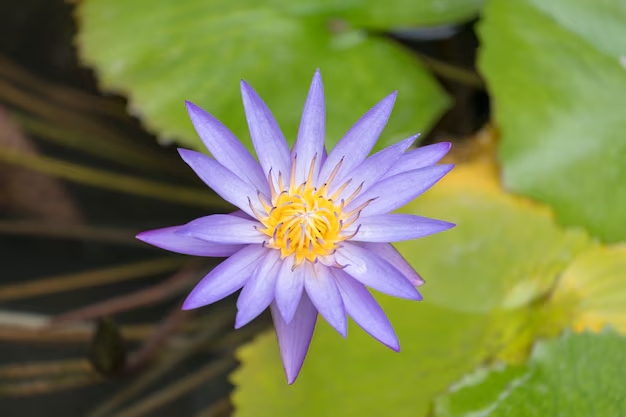The blue lotus flower, scientifically known as Nymphaea caerulea, has captivated civilizations for centuries with its mesmerizing beauty and profound symbolism. Originating from the Nile River in Egypt, this aquatic plant holds a special place in various cultures around the world due to its unique characteristics and historical significance. Let’s embark on a journey to uncover the secrets and mysteries surrounding the enchanting blue lotus flower.
Historical Significance
The blue lotus flower has a rich historical legacy, deeply intertwined with ancient Egyptian mythology and religious practices. In ancient Egypt, the blue lotus symbolized rebirth, fertility, and the sun god Ra. The flower was often depicted in temple carvings, artwork, and religious ceremonies, showcasing its sacred status in Egyptian culture.
Furthermore, the blue lotus held medicinal and spiritual significance in ancient Egyptian society. It was believed to have therapeutic properties, used in herbal remedies and rituals for its calming and euphoric effects. The flower was also associated with the afterlife and was often placed in tombs to assist the deceased in their journey to the next world.
Botanical Features
The blue lotus flower is a striking aquatic plant with delicate petals ranging from pale blue to deep violet. It flourishes in shallow waters, with its roots firmly anchored in the muddy riverbeds. The leaves of the blue lotus are large, round, and float on the water’s surface, providing a picturesque sight that is both serene and captivating.
One of the most intriguing aspects of the blue lotus flower is its unique ability to close its petals at night and reopen at dawn, symbolizing the cycle of life, death, and rebirth. This natural phenomenon adds to the mystical allure of the flower, making it a subject of fascination for botanists and nature enthusiasts alike.
Cultural Symbolism
Across various cultures and civilizations, the blue lotus flower holds diverse symbolic meanings and associations. In Hindu and Buddhist traditions, the lotus flower, in general, represents purity, enlightenment, and spiritual growth. The blue lotus, in particular, is believed to evoke feelings of tranquility, wisdom, and inner peace.
Moreover, in ancient Greek mythology, the blue lotus was linked to the story of the lotus-eaters, a group of people who consumed the flower and fell into a state of blissful forgetfulness. This mythological tale underscores the flower’s association with relaxation, pleasure, and escapism.
Medicinal and Therapeutic Uses
The blue lotus flower has a long history of medicinal and therapeutic applications, dating back to ancient times. In traditional Egyptian medicine, the flower was used to alleviate anxiety, insomnia, and various ailments. Its sedative and analgesic properties made it a popular remedy for promoting relaxation and enhancing mood.
Furthermore, the blue lotus was prized for its aphrodisiac effects, believed to enhance libido and sexual vitality. In Ayurvedic medicine, the flower was used to stimulate the senses, improve cognitive function, and balance the body’s energies. Modern research has also shown promising results regarding the potential health benefits of the blue lotus in relieving stress, promoting sleep, and reducing inflammation.
Culinary and Ritualistic Uses
In addition to its medicinal properties, the blue lotus flower has culinary and ritualistic significance in various cultures. In ancient Egypt, the flower was infused in wine and consumed during religious ceremonies and social gatherings. The intoxicating aroma and flavor of the blue lotus essence were believed to induce a state of euphoria and spiritual awakening.
Moreover, the blue lotus was used in sacred rituals and ceremonies to invoke divine blessings, connect with higher realms, and enhance meditation practices. Its symbolic association with enlightenment and higher consciousness made it a revered plant in spiritual traditions seeking transcendence and inner transformation.
Contemporary Relevance
In modern times, the blue lotus flower continues to captivate people’s imaginations and inspire artistic expressions across different mediums. Its timeless beauty, cultural significance, and therapeutic properties have made it a symbol of purity, serenity, and spiritual awakening in a fast-paced world.
From botanical gardens to art galleries, the blue lotus remains a source of inspiration for creatives, nature lovers, and spiritual seekers alike. Its ethereal allure and mystical charm serve as a reminder of the profound connection between humans and the natural world, inviting contemplation, introspection, and reverence for the wonders of life.
Conclusion
In conclusion, the blue lotus flower stands as a symbol of beauty, spirituality, and transformation, transcending time and culture to touch the hearts and minds of those who encounter its ethereal presence. From ancient civilizations to contemporary societies, the blue lotus continues to weave its magic, offering solace, inspiration, and a glimpse into the mysteries of the universe.
As we delve into the enchanting world of the blue lotus flower, we are reminded of the interconnectedness of all living beings and the enduring power of nature to awaken our senses, heal our bodies, and nourish our souls. May the blue lotus guide us on a journey of self-discovery, enlightenment, and inner peace, as we navigate the ebb and flow of life’s eternal mysteries.




